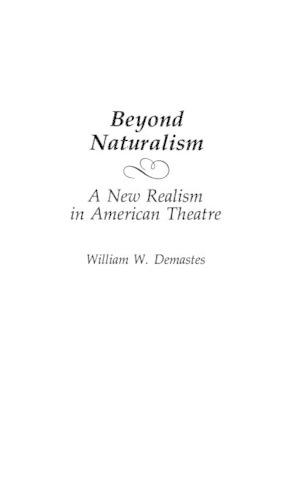
Beyond Naturalism: A New Realism in American Theatre
(Hardback)
Publishing Details
Beyond Naturalism: A New Realism in American Theatre
By (Author) William W. Demastes
Bloomsbury Publishing PLC
Praeger Publishers Inc
15th November 1988
United States
Classifications
Tertiary Education
Non Fiction
Literary studies: c 1900 to c 2000
812.5409
Physical Properties
Hardback
182
Description
Demastes, in his interesting study of the work of David Rabe, David Mamet, Sam Shepard, Charles Fuller, Beth Henley, and Marsha Norman, examines how these playwrights utilize the realist format to redirect perception of human life, how they cope with the consciously taken 'task of challenging old systems of thought from a base of new perspective.' The analyses of individual plays are preceded by a brief review of some earlier dramatic theories of realism revealing the roots and antecedents of the new forms. . . . Beyond Naturalism is a very useful and valuable contribution to drama and theatre studies. American Literature Demastes explores the work of a group of playwrights who have moved beyond the often-maligned naturalist approach to create what he terms the new realism in American theatre. Demastes argues that this new realism is separate and distinct from the narrow focus of naturalism and is the result of tapping into a growing tradition inherited from the experimental work of prior decades such as absurdist theatre and experimentation of the 1960s. The playwrights who most exemplify the new realism--David Rabe, David Mamet, Sam Shepard, Charles Fuller, Beth Henley, and Marsha Norman--are examined in depth. Each has separately taken on the challenge to modify the forms of traditional realism to fit more modern visions of existence. In the process, they have broken from naturalism, infusing realism with fresh and contemporary perspectives of the world around them. Demastes shows that even though these playwrights' return to realism has won them larger audiences and greater accessibility, the break from naturalist logic has sometimes confused American critics and audiences--leading them to conclude such works to be bad drama. To uncover the various points of confusion, Demastes not only analyzes the playwrights' contributions but also examines the critical impressions of their productions to assess the reactions of a theatre-going public raised on naturalist assumptions and now asked to adapt to the new alterations confronting them. This two-pronged approach enables the reader to both explore the evolution of new realism and assess the degree to which it can legitimately be considered a new form of American theatre.
Reviews
Demastes endeavors to show how some contemporary American playwrights are transcending the naturalistic forms of their predecessors by using realistic techniques to challenge these naturalistic precepts. Specifically, he points to a reaction against naturalistic tendencies to point to clear causal factors for behavior and to recommend corrections for social problems. Today's new realists, the author contends, often see human actions and language as ambiguous and without clear cause or logic; they view modern existence as too complex for easy social solutions. Thus they share the outlook of the absurdists but they use surface realism to express their vision. Demastes's critical study of contemporary American playwrights Rabe, Mamet, Shepard, Fuller, Henley, and Norman is a welcome one; it is well balanced and often insightful. However, the narrowly defined concept of naturalism from which Demastes contends that the new playwrights deviate seems to be one that has been left behind since the 19th-century well-made play fell into disfavor. Thus informed audiences and readers may not always find these points to be revelatory; but Demastes's work is valuable in re-emphasizing the flexibility and significance of the realistic approach. The book is well documented, with black-and-white production photographs and a comprehensive bibliography and index. Recommended for upper-division undergraduate and graduate libraries.-Choice
"Demastes endeavors to show how some contemporary American playwrights are transcending the naturalistic forms of their predecessors by using realistic techniques to challenge these naturalistic precepts. Specifically, he points to a reaction against naturalistic tendencies to point to clear causal factors for behavior and to recommend corrections for social problems. Today's new realists, the author contends, often see human actions and language as ambiguous and without clear cause or logic; they view modern existence as too complex for easy social solutions. Thus they share the outlook of the absurdists but they use surface realism to express their vision. Demastes's critical study of contemporary American playwrights Rabe, Mamet, Shepard, Fuller, Henley, and Norman is a welcome one; it is well balanced and often insightful. However, the narrowly defined concept of naturalism from which Demastes contends that the new playwrights deviate seems to be one that has been left behind since the 19th-century well-made play fell into disfavor. Thus informed audiences and readers may not always find these points to be revelatory; but Demastes's work is valuable in re-emphasizing the flexibility and significance of the realistic approach. The book is well documented, with black-and-white production photographs and a comprehensive bibliography and index. Recommended for upper-division undergraduate and graduate libraries."-Choice
Author Bio
WILLIAM W. DEMASTES teaches American literature and drama at the University of Tennessee-Knoxville. He has published articles on modern American playwrights in such journals as Comparative Drama and Studies in American Drama, 1945-Present, and is a contributor to American Playwrights Since 1945 (Greenwood Press, forthcoming 1989).
